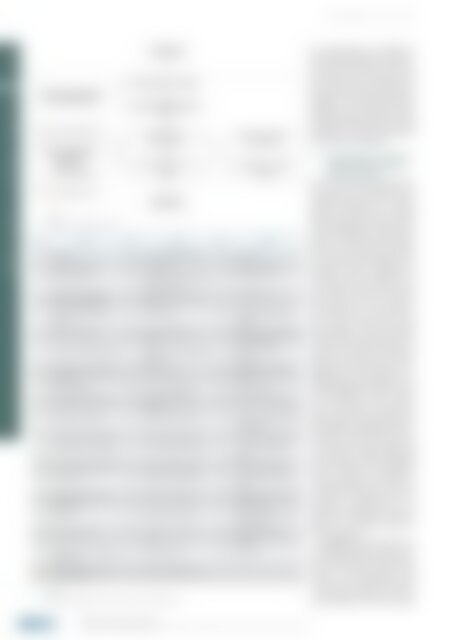atw 2015-01
You also want an ePaper? Increase the reach of your titles
YUMPU automatically turns print PDFs into web optimized ePapers that Google loves.
<strong>atw</strong> Vol. 60 (<strong>2<strong>01</strong>5</strong>) | Issue 1 ı January<br />
ENERGY POLICY, ECONOMY AND LAW 28<br />
| | Fig. 1.<br />
Strategy of GSR Development for SFR.<br />
Art. Title Art. Title Art. Title<br />
1 Definition 21 Use of qualified equipment 41 I&C system<br />
2 Radiation Protection 22 Human factors 42 Electric power system<br />
3 Defense-in-Depth 23 Prevention of harmful effects<br />
between systems<br />
4 Interfaces of safety with<br />
security and safeguards<br />
5 Physical Protection / Safeguards<br />
24 Protection against sodium<br />
reactions<br />
6 Proven technologies 26 Inherent protection of<br />
reactor<br />
| | Tab. 1.<br />
General Safety Requirements (Articles of Technical Standards) for SFR.<br />
43 Control room, etc.<br />
44 Alarm devices, etc.<br />
25 Reactor design 45 Optimization of radiation<br />
protection<br />
7 Assessment of Design Safety 27 Suppression of reactor power<br />
oscillation<br />
8 Construction and operating<br />
experiences<br />
46 Radioactive waste processing<br />
& storage systems<br />
47 Radiation protection<br />
provision<br />
28 Reactor core, etc. 48 Fuel handling & storage<br />
facilities<br />
9 Decommissioning 29 Fuel rod and assembly 49 Auxiliary systems<br />
10 Postulated initiating events 30 Protection against flow<br />
blockage<br />
50 Power conversion system<br />
11 Design bases accidents 31 Reactivity control system 51 Emergency response facilities<br />
and equipment<br />
12 Design extension conditions 32 Reactor protection system 52 Intermediate cooling system<br />
13 Safety classes and standards 33 Use of computerized system 53 Liquid sodium handling<br />
system<br />
14 External events design bases 34 Diverse protection system 54 Sodium heating system<br />
15 Fire protection 35 Reactor coolant boundary 55 Protection against sodium<br />
freezing<br />
16 Design bases for environmental<br />
effects<br />
36 Reactor cooling system 56 Purification control of cover<br />
gas and supply<br />
17 Reliability 37 Overpressure protection 57 Operating experiences and<br />
safety research<br />
18 Sharing of facilities 38 Residual heat removal<br />
system<br />
19 calibration / test / inspection/<br />
maintenance<br />
20 Startup, shutdown, and low<br />
power operation<br />
58 Limiting conditions for<br />
operation<br />
39 Ultimate heat sink 59 Initial tests<br />
40 Reactor containment, etc.<br />
new requirements to be added, we<br />
have referenced the international documents<br />
like IAEA SSR-2/1, Safety Design<br />
Criteria of GIF and draft version<br />
of SFR GDC under development by<br />
ANS. Fukushima action items and applicability<br />
of Risk Informed Regulation(RIR)<br />
are also considered. Utilizing<br />
this strategy and process, we have<br />
developed a draft version of SFR GSR<br />
containing 59 articles. The title of the<br />
articles are listed in Table 1.<br />
3. Development of OPT for<br />
SFR reactivity control<br />
safety function<br />
The OPT is a top-down method with a<br />
tree structure for each DID level describing<br />
objectives and barriers, safety<br />
function, challenges to maintain<br />
safety functions, mechanisms of safety<br />
function degradation, and provisions<br />
for each degradation or failure mechanisms<br />
to maintain safety functions.<br />
Reference [2] describes conceptually<br />
how to apply this methodology to development<br />
of safety requirements for<br />
innovative reactors, specifically for<br />
the modular high temperature gas<br />
cooled reactors. In general, we have<br />
three safety functions to fulfill the<br />
safety objectives, i.e., control of reactivity,<br />
core heat removal and containment<br />
integrity. Among these three<br />
safety functions, we have developed<br />
the OPT for the safety function of “reactivity<br />
control”. Because the design of<br />
PGSFR is not mature yet, we have developed<br />
the OPT modelling the KA-<br />
LIMER-600 [4] reactor which is conceptually<br />
designed by KAERI and is an<br />
SFR of 600 MWe size. OPT is a qualitative<br />
methodology whose development<br />
relies mainly on experiences of<br />
experts using the design documents<br />
like probabilistic safety assessment report.<br />
Because the SFR GSR we are developing<br />
is a general one which should<br />
not be reactor or design specific, we<br />
have developed the OPT for KALIMER<br />
even if the target reactor to apply the<br />
GSR in reviewing is the PGSFR. The<br />
detailed description of the system is<br />
not included in this paper since it is not<br />
necessary to understand the developed<br />
OPT. Example of the Level 3<br />
OPT we have developed for the safety<br />
function of “reactivity control” is<br />
shown in Figure 2.<br />
In Figure 2, safety function means<br />
the essential function necessary to ensure<br />
the safety objectives by maintaining<br />
DID and barrier integrity. Challenge<br />
is the phenomenon which<br />
threatens the successful achievement<br />
of the safety function and the possible<br />
challenges to the safety function<br />
Energy Policy, Economy and Law<br />
Assessment of General Safety Requirements for SFR ı Namduk Suh, Moohoon Bae, Yongwon Choi, Bongsuk Kang and Huichang Yang

















